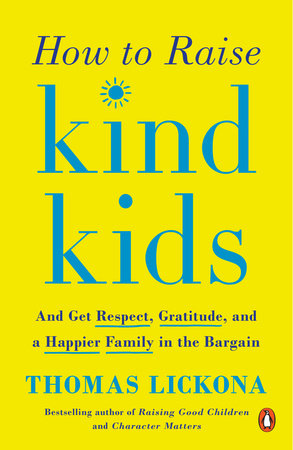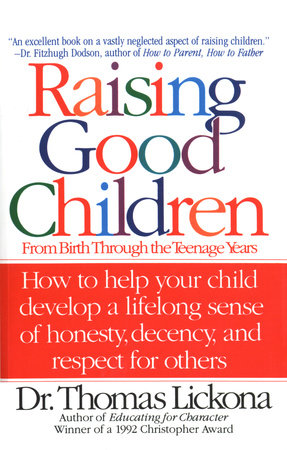What To Do When Your
Child Is Not Kind
by Dr. Thomas Lickona
Kindness is the virtue of thinking of others — caring about their feelings, needs, and happiness. As parents, we want our kids to be kind, thoughtful, and empathetic to those around them — and it can be hard to know how to respond most effectively when they are not. What should you do when your child is not kind, or is frequently unkind and teaching kindness seems to be a real challenge? In both cases, a combination of parenting strategies is needed. Let me share four that can help.
1. Correct aggression — clearly and with feeling. A study of toddlers 1 1/2 to 2 1/2 years of age observed how they responded to another toddler’s crying on the playground. About a third of the toddlers offered comfort or help; the rest did not. The compassionate toddlers, the researchers found, had mothers who were warm and nurturing. These mothers had also taken it very seriously if their own child had hurt someone in the past. For example, a 2-year-old girl who responded compassionately to the crying child on the playground had once pulled another little girl’s hair. When she did that, her mother had responded: “You hurt Amy!” (pointing out the consequence) “Pulling hair hurts!” (an instructive generalization) “NEVER pull hair” (a small moral absolute). This combination of clear teaching and emotional concern sent a strong message to the child: Hurting is a big deal. As a result, this child was subsequently disposed to take it seriously and respond compassionately when she saw another child crying on the playground.
2. Require restitution. We don’t want correction to end with our child feeling bad. They should learn that when they do something wrong, they can and should do something good to make up for it. Whenever possible, restitution should include teaching empathy (“How do you think your brother felt when you said that? What could you do to help him feel better?”) Restitution is an apology of action. One family, to ensure that their kids made amends for misdeeds, had a “Jobs Jar” containing strips of colored paper, each describing a job that needed doing in the house or yard. If you broke a family rule or did anything hurtful, you had to apologize and then pull three strips from the jar, choose one to do, and put the other two back in the jar.
3. Practice the positive. “Virtues aren’t mere thoughts,” Aristotle pointed out; “they are habits we develop by performing virtuous actions.” For kids to develop the habit of speaking and acting kindly, they need lots of practice. That includes opportunities to self-correct. If your 9-year-old son asks his 7-year-old sister for something in a snappish or bossy manner, you can say gently, “What would be a kinder, more respectful way to say that?”
Whenever possible, we also need to try to anticipate and head off problems. One mother said her 7-year-old son hasn’t yet learned to read and is embarrassed about that. His 10-year-old sister Kelly reads exceptionally well. Recently, when Kelly brought some friends over to the house, she introduced her little brother by saying, “This is my brother — he can’t read.” The mom said to me, “She speaks without thinking about the impact of her words, and just isn’t good at putting herself in someone else’s shoes.” Kelly will need coaching from her mom about how to handle different social situations — even role-playing what she might say to make others feel good and not bad. I would also recommend asking Kelly to help her brother with his reading. That would be an authentic responsibility with the potential to increase her empathy and kindness.
4. Read books that cultivate kindness and related virtues. With all kids and especially with kids for whom kindness doesn’t come naturally, good books can be one of our best allies. There are scores of books, fiction and nonfiction, with strong character themes. The more kids read them — with us or on their own — the more they’ll be immersed in goodness and attracted to it.
To be sure, kids need our own good example and the character-building experiences we can provide in family life. But books take them into other worlds where they can learn from the good and bad examples of the story characters, vicariously experience the consequences of the moral choices those characters make, and then transfer those learnings to their own lives. An 11-year-old boy, after reading C.S. Lewis’s The Lion, the Witch and the Wardrobe, talked about Edmund: “He was deceitful by lying to his siblings. I’ve been deceitful by lying about breaking something — I blamed it on my brother. I wouldn’t do that again.”
We can facilitate this kind of transfer from books to life by pausing during a read-aloud to reflect on times when we and our child may have shown the virtue or vice exhibited by a character in the story. Children’s books that depict peer cruelty and exclusion and everyone’s need for friendship — such as The Hundred Dresses by Eleanor Estes and Wonder by R. J. Palacio — are especially good for this kind of parent-child sharing of experiences. What have we done when we saw someone being mistreated? What could we do in the future? The Brightly article “Children’s Books That Show Kids the Goodness in the World” points us to another important resource: picture books that show the many inspiring ways people do good for others. This gives us an opening for talking with our kids about how we too can make a positive difference in the world.
Keep in mind that besides the wholesome values and moral lessons a good book can bring to life, reading together is one of those “connective rituals” that strengthens your bond with your child and enhances your ability to foster their growth in character. When I asked my 7-year-old granddaughter Winnie, “How can parents teach their children to be kind?”, she said, “They should be kind to them.” Reading with your child is one way to do that.
-
Books by the Author
-
How to Raise Kind Kids
Also available from:Educating for Character
Also available from:Raising Good Children
Also available from:



